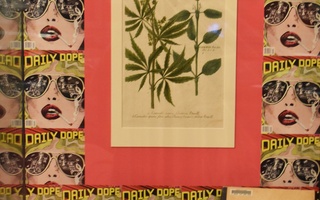The end of October brings bad weather, shorter and shorter days, and, of course, Halloween. For college students, Halloweekend usually means one thing only—get wasted—but some among us still appreciate the eeriness that comes with All Hallow’s Eve. If you are one of those souls, you can add Houghton to the list of places that will make your skin crawl. The library, as a collector of old books and manuscripts, has plenty of creepy stuff that is not the human skin-bound book bound lying around in the stacks, and any horror enthusiast will have a field day exploring the collection items below.
To start off on a more orthodox note, Houghton possesses a fair share of first editions of the Gothic novels that terrorized 19th century minds and made our high school nights a bit more sleepless (mostly because it took hours to read them). Among its holdings are the 1818 first edition of Mary Shelley’s “Frankenstein” (access to which is, unfortunately, restricted due to its fragility—the microforms can be found at Lamont under HOLLIS no. 006587145), the 1897 first edition of Bram Stoker’s “Dracula” in its yellow cloth binding stamped in red (009433204), and plenty of original Edgar Allan Poe serials and books.
On the more modern side, Houghton also has plenty of materials connected to 20th-century American horror icon H. P. Lovecraft. Emilie Hardman, Houghton’s Research, Instruction, and Digital Initiatives Librarian, has written an article about the appearance of old books and manuscripts in Lovecraft’s stories. Ironically, the author’s use of these materials to set “the tone for terror in his work” often leads him to appropriate items that are not at all demonic, and his “book-based horrors are often fleeting, unsubstantiated in the light of day.” Hardman points to one of Lovecraft’s short novels, “The Case of Charles Dexter Ward,” as an example of how the author converts innocent books into harbingers of horror and evil; many of the works Lovecraft mentions in the novel can be found at Houghton. The library is also linked to Lovecraft in a much less obvious way: The board game “Call of Cthulhu,” based on Lovecraft’s œuvre, has a game card depicting Houghton Library, complete with a sinister drawing of the building.
Moving away from fiction and into reality, the library owns some oddly fascinating material concerning Aleister Crowley, a 20th-century British esoteric known for founding the religion of Thelema. A whole set of Crowley’s letters are at Houghton (013362685), and they are creepy, to say the least. Formulaic statements, unrecognizable symbols, and numerology abound, and Crowley signed his letters with the number 666 rather than his name. Crowley also contributed to a set of tarot cards, proofs of which are at Houghton; pentagrams and other eerie imagery are present throughout (013340169).
Finally, since Harvard is so close to Salem, Houghton has more than enough material on witches and witch hunts and trials, from the 19th-century manuscript for Elizabeth Gaskell’s “Lois the Witch”—the cover is laden with pentagrams (009585378)—to whole subject classes on witchcraft. An exploration of the old Widener classes on HOLLIS Classic (begin with 24245 on “other call number”) also yields spooky results from centuries ago, such as a report from 1647 about witches in the English county of Norfolk (005777103) and the description of a 1664 witch trial in Suffolk (007218007). If you have some free time between Halloween parties, do come in to rescue the true spirit of Oct. 31. Happy Halloween, and happy searching!
Read more in Arts
Boston Modern Orchestra Project Elevates Great Contemporary ClassicalRecommended Articles
-
Book Review.Messrs. Houghton, Miffin and Co. have recently published a new edition of Allen and Stoddard's Latin Grammar, revised and improved
-
Funeral of Late C. W. Houghton '13The funeral service of the late Cedric Wing Houghton '13 will be held in Appleton Chapel this afternoon at 2
-
HOUGHTON TREASURE LIBRARY WILL OPEN ON FEBRUARY 28THThe official opening of Houghton Library, recently completed annex to Widener which will be able to house 250,000 of the
-
Let's Get PhysicalAlthough this sounds morbid, death masks are a fascinatingly personal way to come into contact with figures who were larger than life. Death masks also bring us closer to a quintessentially human aspect of these timeless personalities: their mortality.
-
 ‘LSD’ Houghton Exhibit Showcases Counterculture Paraphernalia
‘LSD’ Houghton Exhibit Showcases Counterculture Paraphernalia













